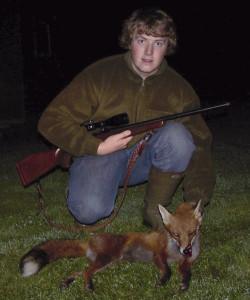243 Win
Although most people think of the .243 Win as a stalking calibre, its origins lie in the pursuit of varmints. A 100-grain bullet may be the default choice for many, but most rifles will shoot better with some lighter fodder. Indeed, most hunters never really get to see the true capabilities of a .243 Win until they downsize to 70 grains or less. It is here that you will see what a tremendous calibre it is for foxing.
Without a decent moderator, the .243 Win does induce enough muzzle flip on recoiling to cause loss of sight picture. This is not at all ideal, but clamp a moderator on the end of your rifle and it's a different animal entirely. Although it may be the heaviest recoiling of the shortlist, moderation makes it only marginally more noticeably than a .22-250 Rem.
Rifle choice and ammunition selection will never be a problem for what is probably the UK's most popular calibre, and for the handloader there are plenty of excellent bullets available for experimentation. It doesn't normally take much to find ammunition to suit a .243 Win, and even factory rifles with factory ammo can return less than ¾in groups with a bit of trial and error.
Most importantly, though, it's a very forgiving calibre when hunting. For me as a gamekeeper/stalker and a paid fox controller in the Hebrides, I need a calibre that is going to put a fox down and keep it down. Like many, I have rotated my gun cabinet through the 'in' calibres of the day, but I keep coming back to the .243 Win. Loaded with 100- or 105-grain bullets, even if bullet placement is a bit off, it will knock a fox off its feet where it stands. The same cannot be said for some of the smaller calibres. Even at 300 yards, the energy is more than 1,000ft/lb, whereas a .223 Rem is almost half that.
The weather on Skye can be unpredictable, with winds whipping up in seconds. The broken, rough terrain makes locating a dropped fox hard enough even when you know where it is. I am not shooting super long ranges, and nor do I want to think about complex ballistics before pulling the trigger – that's for prairie dog hunters and target shooters. With relatively cheap ammo on offer, the .243 Win does everything I want it to do and is my number one choice.
There's no doubting the .220 Swift can put down a fox, but it loses out in comparison to the .22-250, which offers cheaper ammo, greater rifle choice and is friendlier to barrels
It is possible to load a .243 Win very hot indeed, especially with 55-grain bullets. Even with factory loads, these return more than 3,800fps MV, and will vastly reduce the life of your barrel. However, from 70 grains upwards bullet velocities are more modest. If you're worried about flat shooting, the 70-grain bullet offers an excellent compromise. Only dropping 5.5-inches at 300 yards with a one-inch high zero at 100 yards, it still delivers more energy than any of the other calibres listed here.


